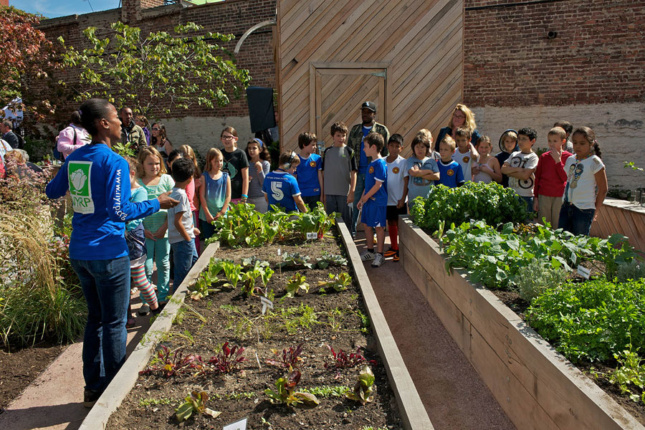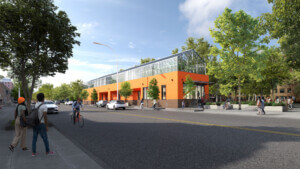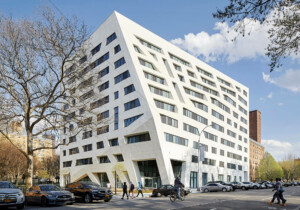As a follow-up to my conversation with Commissioner Silver, I contacted Deborah Marton to speak with her about the New York Restoration Project’s work with under-served communities in New York. The group’s mission states:
New York Restoration Project (NYRP) is a non-profit organization driven by the conviction that all New Yorkers deserve beautiful, high-quality public space within ready walking distance of their homes. Since our founding in 1995 by Bette Midler, NYRP has planted trees, renovated gardens, restored parks, and transformed open space for communities throughout New York City’s five boroughs. As New York’s only citywide conservancy, we bring private resources to spaces that lack adequate municipal support, fortifying the City’s aging infrastructure and creating a healthier environment for those who live in the most densely populated and least green neighborhoods.
Their work with the New York City Housing Authority (NYCHA) was the focus of the discussion.
The Architect’s Newspaper: What is New York Restoration Project doing to address borders?
Deborah Marton: Borders we deal with are perceptual. Systems of management can impose socioeconomic borders on space. An example from our experience is that some people in certain groups don’t go to Central Park because they don’t feel comfortable there. These are people who live within walking distance of the park but don’t feel that it belongs to them as public space.

AN: Can you tell me more about NYRP’s work on public housing sites in New York?
DM: Public housing with the Corbusian tower in the park model is a failed paradigm in its insistence that the green space be green poche. These spaces became a no-man’s land that invited crime. New York City, New York State codified the standard of having fences everywhere making green space unusable and inaccessible. Fences were not just about maintenance. They presented an idea of control and policing.
AN: How did NYRP get involved with the New York City Housing Authority (NYCHA)?
DM: NYRP got involved with NYCHA beginning in 2008 because of the Bloomberg administration ‘Million Trees Initiative’. The Department of Parks and Recreation can only plant trees in parks and along streets. They cannot plant trees in space that is not parkland. The Bloomberg Administration invited NYRP to be its private sector partner because they could work across jurisdictions, including on NYCHA property where there is more open space for planting trees.
AN: Can you explain how your involvement with NYCHA evolved?
DM: Residents of NYCHA started applying to our program “Garden in the City.” The program provides resources to groups in high need areas who apply for support to make public gardens. NYRP supports groups that show the organizational capacity with stewardship and funding for their efforts. As we received more and more requests, the program led to a memorandum of understanding (MOU) between NYCHA and NYRP to do more projects. We are currently working on 50 or 60 NYCHA sites mostly to develop urban agriculture.

AN: How did you engage the larger community?
DM: We hold workshops that are open to the public where we provide education about how to develop, maintain, and manage community gardens. The gardens are also self-governing, managed outside of city structure. People in the neighborhoods around NYCHA projects as well as within can participate.
AN: Beyond breaking down the visual and physical space, how did this change the community?
DM: There are few spaces where people of different socio-economic and racial backgrounds can merge and collaborate. Community gardens create these kinds of places. Community gardens on NYCHA land have a geographic catchment beyond NYCHA property extending to broader neighborhood. We are working not only on gardens in NYCHA property but also have 52 gardens that we developed independently.
Latest social science thinking suggests that social isolation is an ongoing contributing factor in lack of social mobility and advancement, poverty, mental health problems, and violence. Expanding community gardens is one of the most effective and least expensive poverty measures, reducing crime, improving public health.
In a 2011 study the Philadelphia Horticultural Society and University of Pennsylvania Medical School conducted a study about the reuse of vacant lots in Philadelphia. One was control where they did nothing, a second looked group, they cleaned the trash, and in a third they added a simple lawn and fence and maybe a tree. They studied the area from 2011-14 and found that crime went down in groups 2 and 3 with the biggest impact on group 3 where people in the neighborhood reported a reduces feeling of helplessness and depression. You can read more about the project in a Fast Company article that came out earlier this summer entitled The case for building $1,500 parks.
AN: How does NYRP work in New York City compare to the work in Philadelphia?
DM: NYRP has been doing similar work for over 20 years and understood the value qualitatively which is now proven by more quantitative studies. Among the places where NYRP has made significant investment, East Harlem has experienced 150 less felonies/40,000 residents. Crime has dropped in general on the blocks where we built gardens. The community has stronger ties to the garden and to each other. Social capital and presence led to drops in crime.











